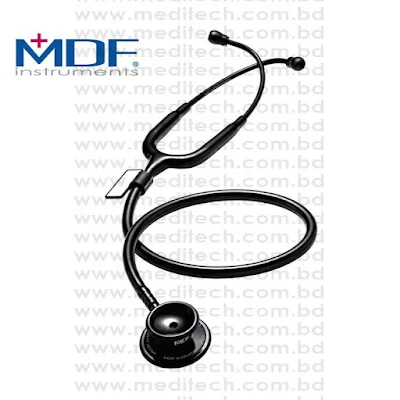The Anatomy of a Stethoscope: Understanding the Different Parts
As a medical professional, the stethoscope is an essential tool in your arsenal. It's the device that helps you listen to the inner workings of the human body, providing vital information that can help diagnose a range of medical conditions. But have you ever really stopped to consider the intricate design of this simple yet powerful instrument? Understanding the anatomy of a stethoscope is essential for getting the most out of your device and improving the accuracy of your diagnoses. From the earpieces to the chest piece, each component plays a critical role in helping you hear the sounds of the body. In this article, we'll take a closer look at the different parts of the stethoscope and explore their functions. Whether you're a seasoned medical professional or a student just starting out, the anatomy of a stethoscope is a fascinating subject that's worth exploring.
Parts of a Stethoscope
Earpieces
The earpieces are the components of the stethoscope that fit into your ears. They are typically made of soft, pliable materials that provide a comfortable fit. There are two types of earpieces: standard and adjustable. Standard earpieces are fixed in size and cannot be adjusted, while adjustable earpieces can be adjusted to fit different ear sizes.
The earpieces are designed to create a seal in your ear canal, which helps to block out external noise and ensure that you hear the sounds of the body clearly. It's important to ensure that the earpieces fit snugly in your ears, as a loose fit can cause the stethoscope to move around, making it difficult to hear the sounds you need to hear.
Tubing
The tubing is the part of the stethoscope that connects the earpieces to the chest piece. It is typically made of rubber or PVC and comes in various lengths. The length of the tubing can affect the sound quality of the stethoscope, with longer tubing generally providing better sound quality.
The material of the tubing can also affect the sound quality. Rubber tubing is more flexible than PVC tubing, which can make it easier to use the stethoscope in tight spaces. However, PVC tubing is more durable and can withstand exposure to oils and other chemicals better than rubber tubing.
Chestpiece
The chestpiece is the part of the stethoscope that is placed on the patient's body to listen to the sounds of the body. It consists of two parts: the diaphragm and the bell. The diaphragm is the larger, flat part of the chestpiece that is used to listen to high-pitched sounds, such as those produced by the lungs and heart. The bell is the smaller, concave part of the chestpiece that is used to listen to low-pitched sounds, such as those produced by the gastrointestinal tract.
There are two types of chestpieces: single-sided and double-sided. Single-sided chestpieces have only one side that can be used to listen to sounds, while double-sided chestpieces have both a diaphragm and a bell that can be switched out as needed.
Diaphragm/Bell
The diaphragm and bell are the two parts of the chestpiece that are used to listen to sounds. The diaphragm is the flat, circular part of the chestpiece that is used to listen to high-pitched sounds, such as those produced by the lungs and heart. The bell is the concave, cup-shaped part of the chestpiece that is used to listen to low-pitched sounds, such as those produced by the gastrointestinal tract.
To use the diaphragm, you should place it firmly on the patient's skin, allowing it to make contact with the surface. This will create a seal that will allow you to hear the sounds of the body clearly. To use the bell, you should hold it lightly against the patient's skin, allowing the cup to capture the sounds of the body.
Additional Features
Tunable Diaphragm
Some stethoscopes come equipped with a tunable diaphragm, which allows you to switch between high and low frequencies without having to flip the chestpiece over. To use the tunable diaphragm, you simply apply more or less pressure to the chestpiece, which changes the frequency response of the diaphragm.
Noise-Reducing Technology
Some stethoscopes come equipped with noise-reducing technology, which helps to block out external noise and improve the clarity of the sounds you hear. This technology can be particularly useful in noisy environments, such as emergency rooms or busy clinics.
 |
| A steth |
Pediatric Attachments
Some stethoscopes come with pediatric attachments, which are designed to make it easier to use the stethoscope on infants and children. These attachments are typically smaller than standard chestpieces and can be used to listen to the sounds of the body on smaller patients.
Choosing the Right Stethoscope for Your Needs
When it comes to choosing a stethoscope, there are a few factors to consider. First, you'll want to consider the type of work you'll be doing. If you work in a busy emergency department, you may want a stethoscope with noise-reducing technology to help you hear the sounds of the body more clearly. If you'll be working with smaller patients, a stethoscope with a pediatric attachment may be a good choice.
You'll also want to consider your budget. Stethoscopes can range in price from less than $20 to several hundred dollars, depending on the features and quality. While it may be tempting to opt for a cheaper option, keep in mind that a high-quality stethoscope can last you for many years and provide you with more accurate readings.
Caring for Your Stethoscope
Proper care and maintenance of your stethoscope can help to ensure that it lasts for many years and continues to provide you with accurate readings. Here are a few tips for caring for your stethoscope:
- Clean the earpieces and chestpiece regularly with a soft cloth and mild soap and water.
- Avoid using alcohol or other harsh chemicals to clean your stethoscope, as these can damage the tubing and other components.
- Store your stethoscope in a cool, dry place away from direct sunlight and extreme temperatures.
- Avoid kinking or bending the tubing, as this can cause damage to the stethoscope.
Conclusion
Understanding the anatomy of a stethoscope is essential for using this valuable tool effectively and getting the most out of it. From the earpieces to the chest piece, each component plays a critical role in helping you hear the sounds of the body. By choosing the right stethoscope for your needs, caring for it properly, and using it effectively, you can provide your patients with more accurate diagnoses and better care.









What is your say on this?